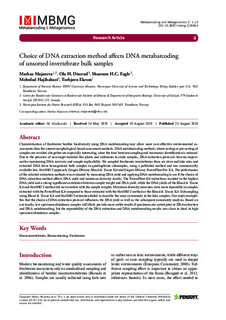| dc.contributor.author | Majaneva, Markus | |
| dc.contributor.author | Diserud, Ola Håvard | |
| dc.contributor.author | Hajibabaei, Mehrdad | |
| dc.contributor.author | Eagle, Shannon | |
| dc.contributor.author | Ekrem, Torbjørn | |
| dc.date.accessioned | 2018-08-27T12:49:58Z | |
| dc.date.available | 2018-08-27T12:49:58Z | |
| dc.date.created | 2018-08-23T19:33:42Z | |
| dc.date.issued | 2018 | |
| dc.identifier.issn | 2534-9708 | |
| dc.identifier.uri | http://hdl.handle.net/11250/2559445 | |
| dc.description.abstract | Characterisation of freshwater benthic biodiversity using DNA metabarcoding may allow more cost-effective environmental assessments than the current morphological-based assessment methods. DNA metabarcoding methods where sorting or pre-sorting of samples are avoided altogether are especially interesting, since the time between sampling and taxonomic identification is reduced. Due to the presence of non-target material like plants and sediments in crude samples, DNA extraction protocols become important for maximising DNA recovery and sample replicability. We sampled freshwater invertebrates from six river and lake sites and extracted DNA from homogenised bulk samples in quadruplicate subsamples, using a published method and two commercially available kits: HotSHOT approach, Qiagen DNeasy Blood & Tissue Kit and Qiagen DNeasy PowerPlant Pro Kit. The performance of the selected extraction methods was evaluated by measuring DNA yield and applying DNA metabarcoding to see if the choice of DNA extraction method affects DNA yield and metazoan diversity results. The PowerPlant Kit extractions resulted in the highest DNA yield and a strong significant correlation between sample weight and DNA yield, while the DNA yields of the Blood & Tissue Kit and HotSHOT method did not correlate with the sample weights. Metazoan diversity measures were more repeatable in samples extracted with the PowerPlant Kit compared to those extracted with the HotSHOT method or the Blood & Tissue Kit. Subsampling using Blood & Tissue Kit and HotSHOT extraction failed to describe the same community in the lake samples. Our study exemplifies that the choice of DNA extraction protocol influences the DNA yield as well as the subsequent community analysis. Based on our results, low specimen abundance samples will likely provide more stable results if specimens are sorted prior to DNA extraction and DNA metabarcoding, but the repeatability of the DNA extraction and DNA metabarcoding results was close to ideal in high specimen abundance samples. | nb_NO |
| dc.language.iso | eng | nb_NO |
| dc.publisher | Pensoft Publishers | nb_NO |
| dc.relation.uri | https://mbmg.pensoft.net/article/26664/list/9/ | |
| dc.rights | Navngivelse 4.0 Internasjonal | * |
| dc.rights.uri | http://creativecommons.org/licenses/by/4.0/deed.no | * |
| dc.title | Choice of DNA extraction method affects DNA metabarcoding of unsorted invertebrate bulk samples | nb_NO |
| dc.type | Journal article | nb_NO |
| dc.type | Peer reviewed | nb_NO |
| dc.description.version | publishedVersion | nb_NO |
| dc.source.volume | 2 | nb_NO |
| dc.source.journal | Metabarcoding and Metagenomics (MBMG) | nb_NO |
| dc.identifier.doi | 10.3897/mbmg.2.26664 | |
| dc.identifier.cristin | 1604156 | |
| dc.relation.project | Miljødirektoratet: 15040013 | nb_NO |
| dc.relation.project | Norges forskningsråd: 243791 | nb_NO |
| dc.description.localcode | Copyright Markus Majaneva et al. This is an open access article distributed under the terms of the Creative Commons Attribution License (CC BY 4.0), which permits unrestricted use, distribution, and reproduction in any medium, provided the original author and source are credited. | nb_NO |
| cristin.unitcode | 194,31,10,0 | |
| cristin.unitcode | 194,63,15,0 | |
| cristin.unitname | Institutt for naturhistorie | |
| cristin.unitname | Institutt for matematiske fag | |
| cristin.ispublished | true | |
| cristin.fulltext | original | |

